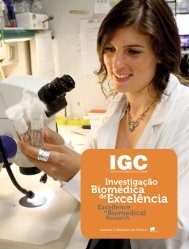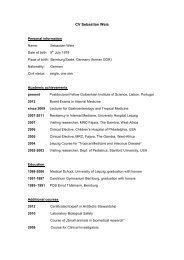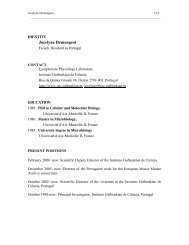organisation - the Instituto Gulbenkian de Ciência
organisation - the Instituto Gulbenkian de Ciência
organisation - the Instituto Gulbenkian de Ciência
- No tags were found...
You also want an ePaper? Increase the reach of your titles
YUMPU automatically turns print PDFs into web optimized ePapers that Google loves.
<strong>the</strong> relationship of <strong>the</strong>se with <strong>the</strong> reproductive success of individuals, however,<br />
is unclear to say <strong>the</strong> least, such that <strong>the</strong>re is little biology at <strong>the</strong> origin of those<br />
terms and notions. Thus, we very well know that “cooperation” is <strong>the</strong> essence<br />
of life from its very inception, chemical cooperation in this case. Many examples<br />
of collective “behaviour” are already available in bacteria, some of which<br />
can be seen as “cooperative”, for <strong>the</strong>y configure conditions in which individuals<br />
differentially provi<strong>de</strong> for a range of common goods that are “exchanged” for<br />
mutual benefit. If “purposeless” genetic variability in populations of unicellular<br />
organisms is <strong>the</strong> solution for <strong>the</strong> unknown future, it also generates standing<br />
genetic variation in <strong>the</strong> populations, that is, it creates <strong>the</strong> “differentiation” of<br />
individuals, however rare <strong>the</strong> variants may be. As one of my bright young colleagues<br />
puts it, if purposeless diversity is <strong>the</strong> solution for <strong>the</strong> unknown future,<br />
<strong>the</strong> differentiation of individuals is <strong>the</strong> rule of nature. Large populations may<br />
accumulate many such “differentiated” mutants, all <strong>the</strong> more so as beneficial<br />
mutations are far more frequent than anticipated, in bacteria, yeast, worms and<br />
flies, at least. Hence, even rare variants may reach consi<strong>de</strong>rable representation<br />
in <strong>the</strong> population. Should one of <strong>the</strong>se produce a “common good”, <strong>the</strong> whole<br />
population profits, changing environments, naturally modulating <strong>the</strong> relative<br />
frequency of each “sub-type”. The greater <strong>the</strong> diversity, <strong>the</strong> higher <strong>the</strong> chance<br />
for <strong>the</strong> emergence of new “common goods”, that is, for cooperation. This does<br />
not infringe Hamilton’s rule, for <strong>the</strong> populations must remain highly related, as<br />
a condition to use <strong>the</strong> new “common good”. As Maynard Smith had told us, all<br />
“major transitions” in <strong>the</strong> ways of being alive have been of a cooperative nature,<br />
such that biologists do have an acute sense of <strong>the</strong> advantages, of <strong>the</strong> “fitness<br />
increases”, that are affor<strong>de</strong>d by “sharing” with o<strong>the</strong>rs any given particular way<br />
of living. If I were to pick one single item from <strong>the</strong> “ethos” catalogue of <strong>the</strong><br />
IGC, I would certainly choose “cooperativity” for all that it implies. Diversity, to<br />
start with, for i<strong>de</strong>ntical individuals gain little in being toge<strong>the</strong>r, if we are looking<br />
for “emergent novelty”; <strong>the</strong> group may gain, particularly if individuals are<br />
submitted to a stringent rule, in (biological) brave new worlds of alphas, betas<br />
and gammas, but those are not <strong>the</strong> kind of worlds we are after. Naturally, each<br />
IGCer takes a lot from many of <strong>the</strong> o<strong>the</strong>rs, as she or he provi<strong>de</strong>s various kinds<br />
of “goods” to many of <strong>the</strong> o<strong>the</strong>rs. If looking at a single variable “good”, we may<br />
i<strong>de</strong>ntify those that take more than give, and some would speak of “cheaters”.<br />
However, <strong>the</strong> “cheaters” for a particular “common good” may well be <strong>the</strong> most<br />
altruistic for ano<strong>the</strong>r. In short, <strong>the</strong> “tragedy of <strong>the</strong> commons” seems more apparent<br />
than real, again solved by <strong>the</strong> diversity of individuals. This must be true,<br />
as <strong>the</strong>re is little or no “policing”, few rules, and yet, <strong>the</strong>re are no cheaters at <strong>the</strong><br />
Institute. Only because, I would think, we do have a common goal that goes well<br />
beyond <strong>the</strong> diversity of individual interests.<br />
The last year at <strong>the</strong> IGC was most successful for many of my colleagues. Over<br />
150 publications have appeared in <strong>the</strong> international scientific literature with an<br />
affiliation to <strong>the</strong> IGC, many in <strong>the</strong> most cited journals in <strong>the</strong> respective fields:<br />
this was <strong>the</strong> year in IGC’s life with a highest number of publications (some 1,700<br />
for its whole 50 years of life, with over 1,100 since <strong>the</strong> last reform). For <strong>the</strong> first<br />
time in its history, citations of work done at <strong>the</strong> IGC have reach over 4,000/year<br />
(more than 30,000 citations from its foundation, over 20,000 of which for work<br />
published since 1998). IGC’s scientists gained several prestigious international<br />
grants and awards, and <strong>the</strong>y were joined in this success by IGC’s alumni who are<br />
now at o<strong>the</strong>r Portuguese institutions. Given <strong>the</strong> IGC’s mission of educating or “importing”<br />
and <strong>the</strong>n “incubating” <strong>the</strong> best young scientists, only to “export” <strong>the</strong>m to<br />
o<strong>the</strong>r Portuguese institutions, this is a most rewarding outcome. The numbers for<br />
<strong>the</strong> last five years help to reveal <strong>the</strong> IGC’s role in <strong>the</strong> revolution of Life Sciences<br />
in Portugal. For example, thus far, a total of 18 European Research Council grants<br />
were awar<strong>de</strong>d to scientists working in Portugal, 11 of which in Life Sciences: 10 of<br />
<strong>the</strong>se 11 were given to investigators who are or have been at <strong>the</strong> IGC. If <strong>the</strong> Life<br />
Sciences appear as <strong>the</strong> most competitive research area in Portugal, <strong>the</strong>refore,<br />
this is largely due to IGC’s alumni. Similar results can be seen with programmes of<br />
o<strong>the</strong>r international funding agencies: <strong>the</strong> recent Howard Hughes Medical Institute<br />
“International Early Career Scientists”, <strong>the</strong> Human Frontiers Science Programme,<br />
and <strong>the</strong> Bill & Melinda Gates Foundation “Grand Challenges”. In short, <strong>the</strong> IGC has<br />
contributed to 20 of 23 such grants given to scientists in Portugal. The Institute<br />
itself has also been recognised: <strong>the</strong> IGC was awar<strong>de</strong>d an Honorary Membership of<br />
<strong>the</strong> Or<strong>de</strong>m <strong>de</strong> Sant'Iago da Espada, by <strong>the</strong> Presi<strong>de</strong>nt of <strong>the</strong> Portuguese Republic,<br />
received <strong>the</strong> Oeiras Medal of Honour, <strong>the</strong> highest attributed by <strong>the</strong> Municipality,<br />
and for <strong>the</strong> second consecutive year, <strong>the</strong> IGC was ranked by “The Scientist - Faculty<br />
of a 1,000” as one of <strong>the</strong> 10 best places for post-docs to work outsi<strong>de</strong> <strong>the</strong> USA.<br />
Thus, we very well know that “cooperation”<br />
is <strong>the</strong> essence of life from its very inception,<br />
chemical cooperation in this case.<br />
Many examples of collective “behaviour”<br />
are already available in bacteria, some of<br />
which can be seen as “cooperative”, for<br />
<strong>the</strong>y configure conditions in which individuals<br />
differentially provi<strong>de</strong> for a range<br />
of common goods that are “exchanged” for<br />
mutual benefit.<br />
The greater <strong>the</strong> diversity, <strong>the</strong> higher <strong>the</strong><br />
chance for <strong>the</strong> emergence of new “common<br />
goods”, that is, for cooperation.<br />
If I were to pick one single item from <strong>the</strong><br />
“ethos” catalogue of <strong>the</strong> IGC, I would certainly<br />
choose “cooperativity” for all that it<br />
implies.<br />
IGC ANNUAL REPORT ‘11<br />
THE DIRECTOR'S INTRODUCTION<br />
8






